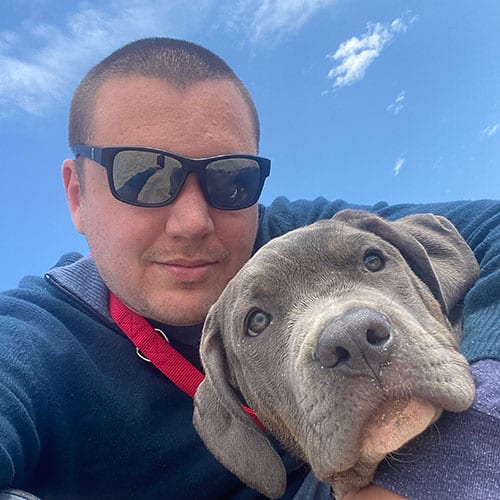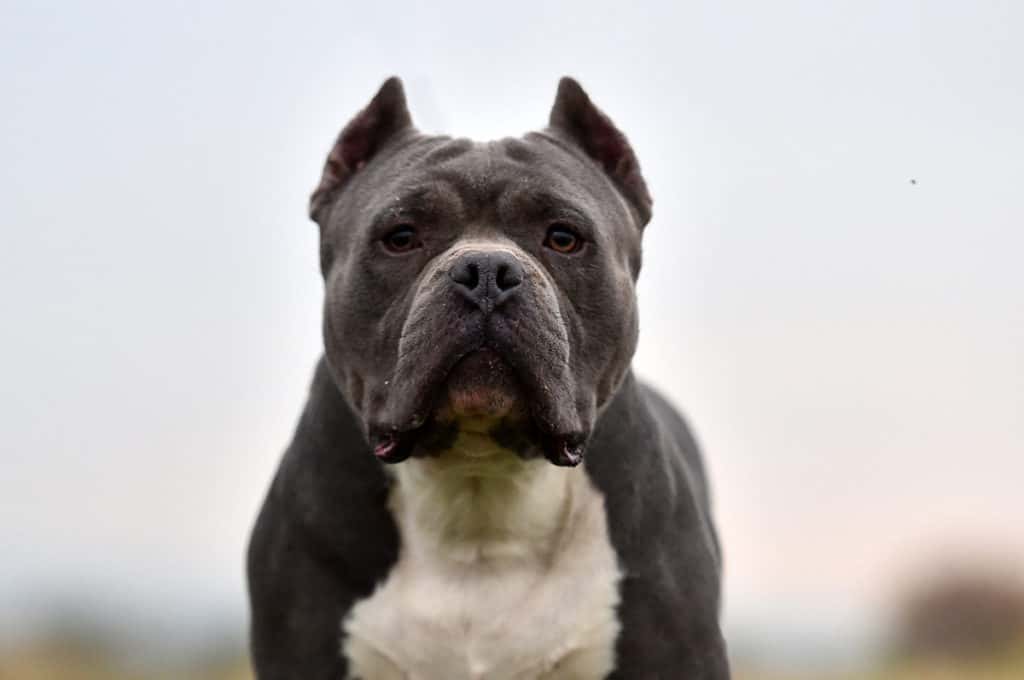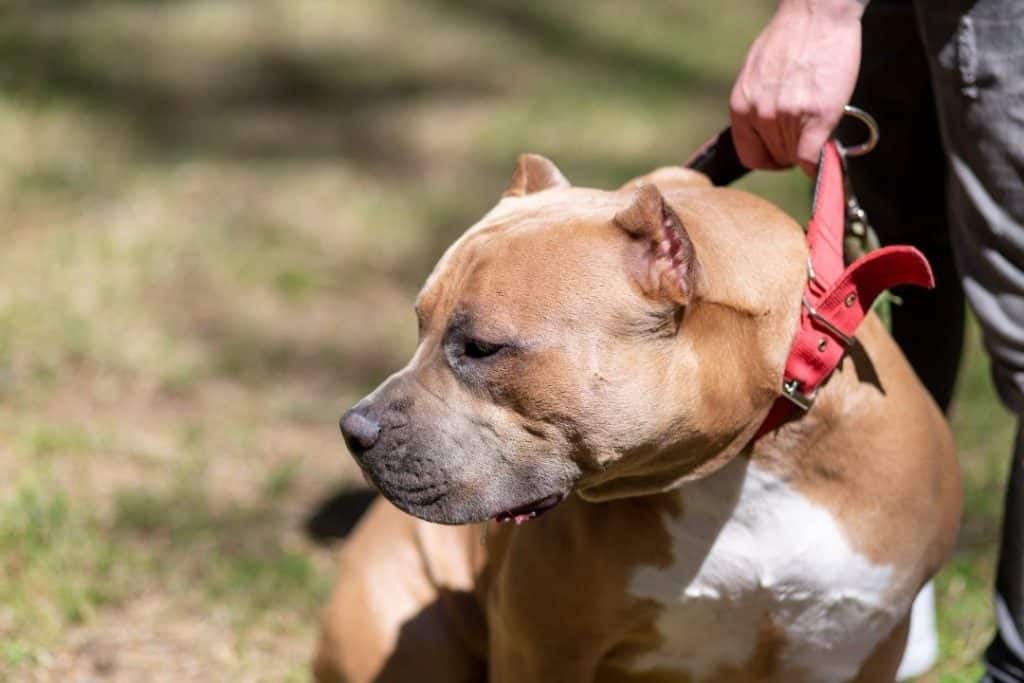This article may contain affiliate links, and I will be compensated if you make a purchase after clicking on my links (at no additional cost to you)
Cropping is an optional surgical procedure that many pet owners believe makes their canine companion look better, while also improving their hearing abilities and ear hygiene.
It’s a controversial procedure, which is illegal in a number of countries. But the American Kennel Club stands behind it as one that’s often necessary. Whether you’ve cropped your American Bully’s ears or are considering doing so, know that healing may take awhile and involves a lot of care.
The American Bully ear crop healing process varies from dog to dog, but there are ways to speed along the healing process. Bandage the canine properly, use a cone, remove scabs as they form, and clean the dog’s ears regularly. A healthy, balanced diet also quickens the healing process.
Postoperative care is crucial as it ensures your canine companion heals quickly and properly. In this article, we’ll take a closer look at the American Bully ear crop healing process, from the initial visit to different cropping styles and costs.
Initial Ear Cropping Visit
If you have yet to establish care with a veterinarian, you’ll typically need to do so before scheduling your American Bully’s ear cropping surgery. Be sure to check reviews and select a reputable vet that has experience with ear cropping.
After you have settled on a vet, the next step is to take your furry friend in for examinations to determine if he or she will be okay with the anesthesia. The assessment may involve some blood tests. If a go-ahead is given, then the procedure can be done.
Your vet may also give you instructions to observe before the cropping procedure. For instance, you may be asked to limit the amount of food you give your dog the night before and curb your American Bully’s water intake the morning of the procedure.
Although not a must, it is advisable to observe the vet’s instructions to minimize the likelihood of complications during and after the procedure.
Post-Operative Care: Bandaging and Using the Cone
Once the veterinarian has cropped your dog’s ears, you’ll begin post-operative care.
Be warned that your American Bully might be in pain, and he’ll come home with bandages covering the wounded, cropped areas.
Don’t fret too much about your American Bully’s pain — your vet will prescribe pain medication to minimize any discomfort caused by the cropping procedure. Don’t hesitate to give your American Bully painkillers whenever he’s in pain. But if the pain becomes too much, consulting with your vet is highly recommended.
As part of the post-operative care, you should re-bandage your bully every week as it helps to keep the wound clean and curb infections.
It would help if you discouraged your furry friend from scratching the cut area, as it can worsen the injury and interfere with the healing process.
However, since it’s practically impossible to prevent your dog from scratching (and potentially aggravating the cropped ears), using a cone is the best approach.
A cone will prevent your pup’s legs from scratching the cropped ears. An example of a good cone is the Supet Adjustable Dog Cone from Amazon.com that has a soft fabric edge for additional comfort.
Removing Scabs To Promote Healing
Scabs hinder the healing process after an ear crop procedure and should therefore be removed from your bully’s ears.
Removing the scabs can be done by soaking the ear using a wet cloth and warm water, then wiping them off gently. Doing this daily can help to identify and treat any infections on the ears.
A visit to the vet a week or two after the procedure to remove the stitches will also help your canine companion heal well.
Maintain a Healthy Diet
Your puppy just had surgery, so eating healthy is vital as it helps them heal faster as they grow.
You can also include a high quality supplement like the Dogzymes Vitamin C Blend from Amazon.com to your American Bully’s diet to boost his immunity after the procedure, which helps keep infections at bay while promoting fast healing.
As a good rule of thumb, you should keep your American Bully puppy on a healthy diet like the Orijen Puppy Large Grain-Free Dry Puppy Food, which contains 85% animal ingredients and essential proteins, vitamins and minerals for fast healing.
You should notify your vet if your puppy refuses to eat after the surgery or has diarrhea, as these can be signs of more severe complications.
Keep Your American Bully’s Ears Cleaned
Maintaining hygiene is vital in ensuring your four-legged friend’s cropped ears don’t get infected. Two to three times a day, you should wipe your dog’s ears with a soft, clean cloth and a vet recommended (or prescribed) product.
If aftercare is done properly, your American Bully’s ears will heal as expected. Taping may be done if there is difficulty in getting the ears to stand. It takes approximately four to eight weeks for a dog’s ears to completely heal after ear-cropping surgery.
As an XL Bully owner, I strongly advise all dog owners to pay close attention to their canine companion’s ears during this process. Consult your veterinarian immediately if you notice additional pain, redness, or swelling around the wound. Additionally, keep an eye out for any bad smells, discharge, or signs that your dog is in extreme pain. Your dog’s ear canals are also more exposed after cropping, so keep an eye out for any particles that may enter their ears.
What Is the Best Age for Ear Cropping?
The best age to have an American Bully’s ears cropped is between 7 and 12 weeks. At this age, the experience tends to be less traumatic. Weight may also play a role in whether or not a veterinarian will perform the procedure. The ideal cut-off weight is 15 to 20 pounds (6.8 to 9.1 kg).
Most veterinarians will also refuse to crop your puppy’s ears if they are above the recommended age and weight. Still, others can allow for the procedure if they are up to 16 weeks old.
While you might be able to find a vet that will crop your pup’s ears if they are much older, expect the process to be distressing for them.
Keep in mind that it is a painful procedure at whichever age, but the healing process will almost certainly take longer for older dogs.
What Are the Ear Cropping Styles?
Ear cropping styles for American Bullies include (in order of the length of the crop, from shortest to longest): Battle crop, short crop, show crop, and long crop. Battle crop is no longer preferred. Short crop is the most common, whereas long crop keeps the ears longer. Show crop is for show dogs.
Battle Crop
The battle crop is the shortest type that became popular back when dogfighting was prevalent. The crop was made so that dogs wouldn’t bite each other’s ears as they fought.
Battle crop style isn’t preferred anymore as it leaves your bully’s ear canals exposed and susceptible to infections.
Short Crop
Unlike its name, this crop is longer than the battle crop. The short crop is ideal as most of your dog’s ears won’t be cropped ensuring its canals aren’t left vulnerable to dirt. This type of cropping is the most preferred as it sits between the battle and show crops. Most dogs that have their ears cropped are cropped with this style.
Show Crop
As the name suggests, the show crop was made for show dogs. It’s not mandatory for show dogs to have this particular look to compete in contests. However, many American Bully owners prefer this crop due to its attractive look when the dog’s ears are erect. This style is more popular than the long crop, but less popular than the short crop.
Long Crop
This look involves cropping off about a quarter of your furry friend’s ear length. It is not popular among American Bully owners as it gives your best friend a mean and fierce look, which American Bullies aren’t. Another name for this crop is the “Tall Crop.”
The short and show crops are the most preferred as they allow your dog’s ears to remain erect.
How Much Does It Cost To Do Ear Cropping?
The cost of canine ear cropping ranges from $150 to $600 (€133 to €532) — but a higher price doesn’t guarantee a better crop. An average, fair price for ear cropping is around $300 (€266) and should cover all costs from the procedure to follow-ups. With that said, prices vary among veterinarians.
Wrapping Up
If you choose to crop your American Bully’s ears, it is highly advisable to take extra precautions to ensure your canine companion recovers in the shortest time possible.
Besides regular cleaning and removal of scabs, you should also invest in a healthy, well-balanced diet to boost the chances of recovery.
Remember to consult with your local vet immediately if you notice any complications like infections, excessive diarrhea, abrupt behavior change and extreme loss of appetite.

I created this blog to share my passion for bullies, and help current and future pitbull owners with things like diet and education.
Hope you find it useful, don’t hesitate to drop a comment on my articles!



